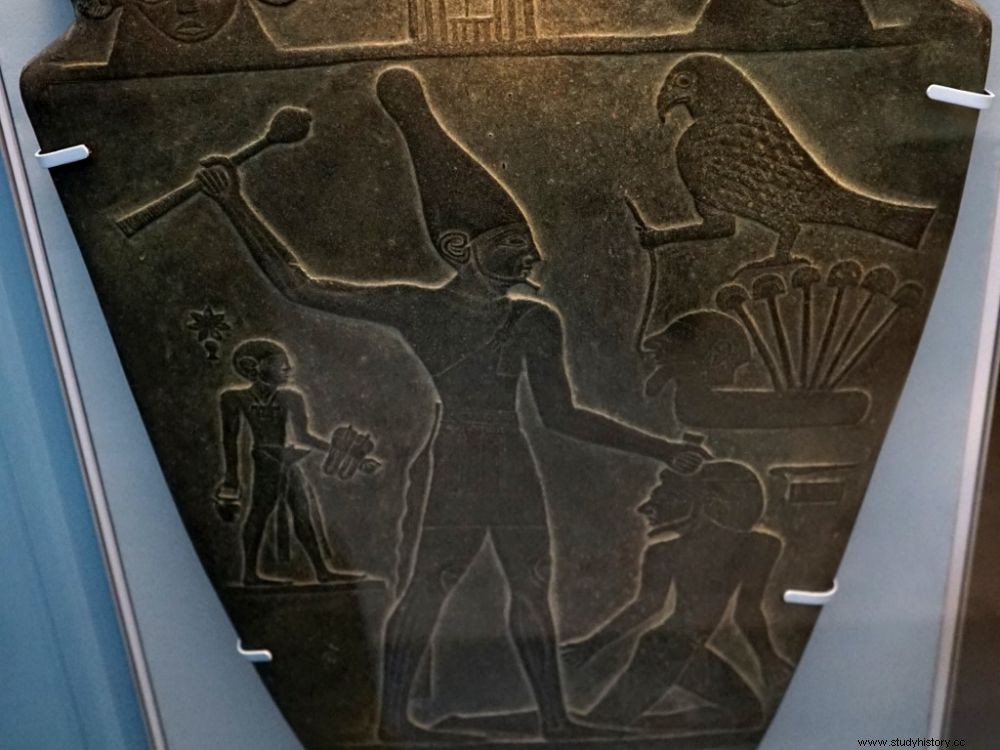State, writing, divinities... At the end of the Neolithic era, and even before the first pharaohs had unified the country, the foundations of Egyptian civilization were already there.

Front of the so-called Narmer make-up palette. We see a unifying pharaoh of Egypt represented wearing the white crown of Upper Egypt slaying his enemies.
This article is from the Special Issue of Sciences et Avenir n°197 dated April-May 2019.
History
PREDYNASTIC PERIOD (BEFORE 3100*)
From the fourth millennium, the first cities (Nagada, Hierakonpolis or Elephantine) appeared in the Nile Valley, in the south of the country. They are governed by an elite that develops refined craftsmanship (vases, make-up palettes). In a few hundred years, the peoples of the Delta gradually adopted the same culture as those of the South.
THINITE PERIOD (3100-2700)
Around 3100, King Narmer - called Menes by the Greeks, and sometimes identified with a king named Aha - founded the 1st dynasty, called thinite, because he was probably from This (Upper Egypt). For the first time, the pharaoh reigns over the two major regions of the country, Upper Egypt (Nile valley) and Lower Egypt (river delta), each with specific deities and rites. This sovereignty over the whole territory is symbolized by the wearing of the double crown. Abydos, where the royal necropolis is located, becomes the religious capital.
Politics and religion
Under the 2nd dynasty appeared the great deities like Horus (falcon god assimilated to the sky or the sun) and Hathor (goddess of the sky and of love), or even Min, the god of fertility and fecundity. Small sanctuaries, mainly in raw brick, shelter a cult to the deities.
At the junction of Upper Egypt and Lower Egypt, Memphis was founded by Menes (probably Narmer) around 3100. The city would become the political and economic center of Egypt. A centralized and structured administration is gradually being put in place which may explain the longevity (3000 years!) of Egyptian royalty.
The emblematic figure
King Scorpion, a predynastic ruler, remains an enigma. We only know that his tomb, at Abydos, contains the first attested hieroglyphs. Two centuries separate him from Narmer, unifier of the country.
Sites and monuments
Abydos, on the west bank of the Nile, is the place where the first pharaohs are buried, then those of the Thinite era - except for the first three kings of the 2nd dynasty who rest in Saqqara. The tombs - like that of Narmer - are dug into the ground and the walls lined with mudbrick. It is not known what the superstructures that covered these early burials looked like.
The Mastaba, a new type of tomb, appears from the end of the predynastic period. It is a trapezoidal construction, with mud brick walls, covering an underground vault. The first is built by King Aha (1st dynasty) in Nagada, southeast of Abydos. A tomb he intends for his mother, himself being buried in Abydos. Later, under the 2nd dynasty, after the foundation of Memphis by Narmer, mastabas were also erected at Saqqara, on the desert plateau which dominates the city. These constructions will not be generalized for dignitaries until later, in the Old Kingdom.
Artistic treasures
The Palermo stone (5th dynasty), in black basalt, a fragment of which entered the museum of Palermo (Sicily) in 1877, is an engraved slab relating to the royal annals. They mention the significant events of the reign of the monarchs until about 2470. You can read information about the height of the Nile floods, the collection of taxes or the construction of temples.
The Narmer palette, a 63 centimeter high historiated make-up palette discovered in a sanctuary in Hierakonpolis (around 3000), is the first testimony to the unification of Egypt. The pharaoh is represented there wearing the white crown of Upper Egypt on the front and the red one of Lower Egypt on the back, a sign that his authority extends over the whole country. We also see him defeating his enemies. Are these real battles that would have presided over the gathering of the two Egypts, or symbolic struggles? The question remains.
Arts and techniques
Hieroglyphic writing around 3300, around the same time as Sumerian writing in Mesopotamia. The oldest hieroglyphs (from the Greek "sacred engraving") come from Abydos (tomb U-j).
Pro-dynastic craftsmanship developed during the Nagada cultures (3800-3100). Craftsmen produce club heads, cosmetic palettes and colored pottery, then ceramic vases with geometric or figurative motifs as well as carved ivories.
Monumental architecture in raw brick was born in the Thinite period. Thanks to it, cities, palaces and tombs like those of Saqqara were built, the largest necropolis in the country from that time... and until the end of Egyptian history.
Egypt and its neighbors
In predynastic times, trade with Palestine is attested by wine jars imported from this region and found in the tombs of Abydos.
*All dates mentioned in this article are before the Christian era.
By Laureen Bouyssou
